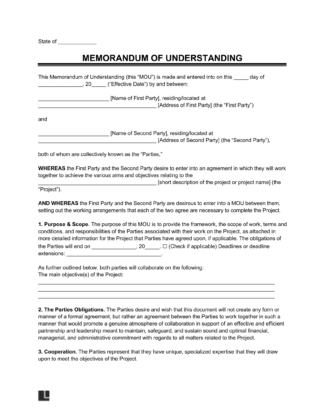
Use our memorandum of understanding template to outline an agreement between two or more parties.

Updated August 19, 2024
Written by Sara Hostelley | Reviewed by Brooke Davis
A memorandum of understanding (MOU) outlines a preliminary agreement between two or more parties in a formal document. It communicates the mutually accepted expectations of a potential purchase, negotiation, or other transaction.
Depending on the agreement’s scope, the MOU can be between individuals, organizations, or governments. It describes the principal terms of a proposed commitment and signals that a binding contract is imminent.
No. A memorandum is not legally binding because it only signals the willingness of the parties to move forward with a contract.
Writing an MOU is still significant because of the time and effort necessary for negotiating, discussing, and drafting an effective document. When an individual knows that the other party intends to enter an agreement, they can have more confidence in the rest of the transaction.
Here are some common elements to include in an MOU:’
A memorandum of understanding provides evidence of intent and good faith and helps set expectations with another party. Here are some instances when you’d benefit from using an MOU:
Here are some instances when you’d use a memorandum of understanding:
The first step in the process is when the parties meet to identify a mutual goal or interest that could benefit from collaboration.
They participate in discussions and negotiations to describe their resources, objectives, and expectations for the partnership or project.
Example:
Two tech companies, one specializing in artificial intelligence (AI) and the other in data analytics, begin exploring a potential collaboration. After several meetings, they agree to draft an MOU to outline their mutual goals and contributions. This MOU serves as a roadmap for their collaboration, ensuring both companies understand their roles before committing to a formal contract.
Referencing their initial discussions and negotiations, both parties work together to draft the MOU and capture the agreed-upon terms. The terms should include the agreement’s purpose, each party’s roles and responsibilities, the resources each party will contribute, timelines, and any specific clauses or conditions.
Example:
A university and a biotech company agree to collaborate on vaccine research. In their MOU, they outline key terms: the university handles laboratory research, and the biotech company supplies materials and funding. This ensures both parties understand their responsibilities and expectations before proceeding.
Each party should review the MOU and make revisions as necessary. This stage invites feedback to ensure the document accurately reflects the agreement. Each party can discuss any concerns about potential legal implications or binding clauses with an attorney.
Once both parties acknowledge the MOU’s terms and agree on its included provisions, each party or their representative can sign it. By adding their signatures, the parties show their commitment to the MOU’s terms.
Although an MOU isn’t legally binding, it represents each party’s intention to work together.
After signing the memorandum, both parties should implement its terms and fulfill their expected responsibilities and roles.
This document acts as a reference for the collaboration or project, ensuring that all parties stay on the same page with the agreed-upon terms and objectives.
Please note that because this document isn’t legally binding, the parties can adjust their work processes as necessary. They should also regularly communicate and monitor the progress of their collaboration. They can refer to the MOU to address any disagreements or clarify ambiguities.
Example:
Once signed, an MOU between a city government and a construction firm for a new public park initiates monthly meetings. This allows both parties to monitor progress, address issues, and adjust plans as necessary, ensuring the project stays on track according to the agreed-upon terms.
The MOU remains effective until the parties complete their combined project or the MOU’s expiration date arrives (if it specified one).
If either party wants to exit the agreement, they should refer to the MOU’s termination terms so they can do so gracefully.
Example:
A non-profit and a corporate partner conduct a joint fundraiser as per their MOU. Post-event, they assess if all duties were fulfilled. The MOU expires after the project, but if the non-profit needs an early exit, they consult the MOU’s termination clause for a smooth departure without violating agreements.
Depending on both parties’ goals, they may transition the MOU into a legal contract and formalize their collaboration.
This process involves writing a new document and including additional conditions, terms, and adjustments necessary for a formal, enforceable contract.
If both parties agree to the suggested terms, they can sign their new business contract into effect.
Example:
A healthcare provider and a technology company decide to enter a formal contract after a successful pilot of their telemedicine platform, as planned in their MOU. This new agreement expands on the MOU by detailing service agreements, intellectual property rights, and revenue-sharing plans, thus cementing their long-term partnership.
Download a free memorandum of understanding template as a PDF or Word file below: